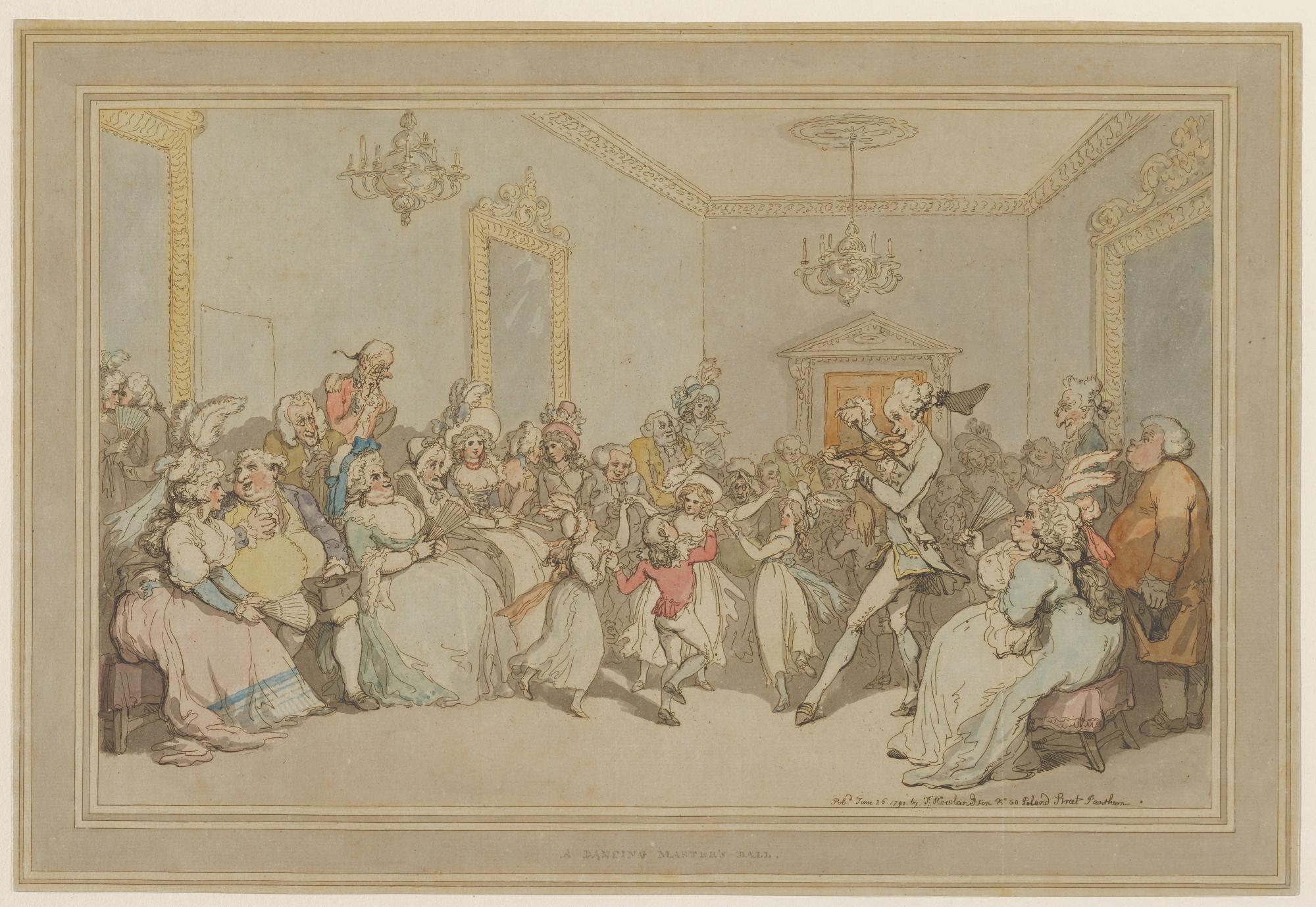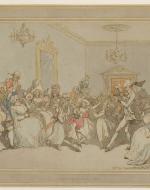Created by Abigail Smagala on Tue, 10/08/2024 - 21:27
Description:
This image is Thomas Rowlandson’s “A Dancing Master’s Ball (Assembly Room at Bath).” This image is dated June 26, 1790, and is one of Rowlandson’s many illustrations showcasing the Bath Upper Assembly Rooms. The Bath Assembly Rooms were designed by John Wood the Younger in 1771 and were restored in 1963.
As chronicled in the second edition of the Cambridge Companion to Jane Austen, Austen and her family spent a significant amount of time visiting and residing in Bath. Austen herself lived in Bath from 1801-1805 and visited the Upper Rooms in 1801. She took enough of a liking to the city and was so inspired by it that two of her novels – Persuasion and Northanger Abbey –are partially set there.
The Bath Assembly Rooms, also called the Upper Rooms, were the site of weekly balls. The location hosted a dress ball on Mondays and a fancy ball on Thursday evenings.Other assembly rooms were also popular at the time, with one of the most widely discussed ones being the highly exclusive and fashionable Almack’s Assembly Rooms. Despite being a public assembly that anyone could purchase tickets to attend, Almack’s became somewhat of a private club with subscriptions being controlled by patronesses. Assembly rooms at this time varied in layout, but all consisted of three separate spaces for different activities. They all contained a ballroom for dancing, a card room, and a tearoom for refreshments.
Private balls were also hosted at the time, and they often were held at country houses. Having assemblies at these locations later fell out of favor as they began to be regarded as less prestigious than the events being hosted at locations like hotels, town halls, and theaters. While public assemblies were open to anyone who was able to purchase a ticket, private assemblies were organized by a hostess who chose the venue — usually her own home — and curated the guest list.
Both public and private assemblies are present in Pride and Prejudice, which solidifies the social standing of the Bennet Family. In addition to having personally been invited to the Netherfield Ball, they would have had enough money to purchase tickets for their daughters to attend the public Meryton assembly. A ticket to a public assembly could cost up to £1, which adjusted for today is approximately $130 USD. The Bennets were not a part of the upper class but were not a part of the poorest class.
Works Cited
Austen, Jane. Pride and Prejudice. 2008 ed., Penguin Books, 2011.
"Balls at the Upper Assembly Rooms, Bath." Regency History, www.regencyhistory.net/blog/upper-assembly-rooms-bath-balls. Accessed 3 Oct. 2024.
Copeland, Edward, and Juliet McMaster, editors. The Cambridge Companion to Jane Austen. 2nd ed., Cambridge UP, 2014.
Mullan, John. "Jane Austen: Strictly Ballroom." The Guardian, 3 May 2013, www.theguardian.com/books/2013/may/03/jane-austen-strictly-ballroom. Accessed 1 Oct. 2024.
Rendell, Jane. "Almack's Assembly Rooms: A Site of Sexual Pleasure." Journal of Architectural Education (1984-), vol. 55, no. 3, 2002, pp. 136-49. JSTOR, www.jstor.org/stable/1425532. Accessed 7 Oct. 2024.
Rowlandson, Thomas. A Dancing Master's Ball (Assembly Room at Bath). 26 June 1790. Minneapolis Institute of Art, collections.artsmia.org/art/77371/a-dancing-masters-ball-thomas-rowlandson. Accessed 7 Oct. 2024.
Stovel, Nora Foster. "'A Country-Dance as an Emblem of Marriage' in Northanger Abbey." Persuasions On-Line, vol. 40, no. 1, winter 2019. Jane Austen Society of North America, jasna.org/publications-2/persuasions-online/volume-40-no-1/stovel/. Accessed 3 Oct. 2024.
Thompson, Allison. "The Rules of the Assembly: Dancing at Bath and Other Spas in the Eighteenth Century." Persuasions On-Line, vol. 31, no. 1, winter 2010. Jane Austen Society of North America, jasna.org/persuasions/on-line/vol31no1/thompson.html. Accessed 7 Oct. 2024.
Copyright:
Associated Place(s)
Part of Group:
Featured in Exhibit:
Artist:
- Thomas Rowlandson


